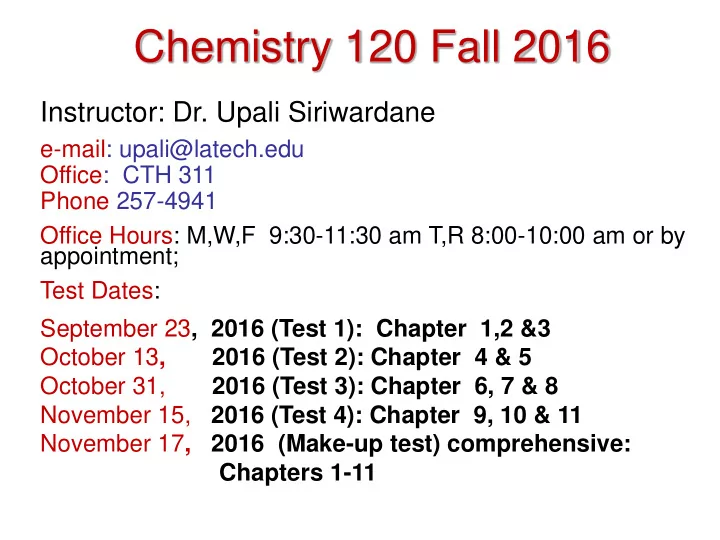

Chemistry 120 Fall 2016 Instructor: Dr. Upali Siriwardane e-mail: upali@latech.edu Office: CTH 311 Phone 257-4941 Office Hours: M,W,F 9:30-11:30 am T,R 8:00-10:00 am or by appointment; Test Dates: September 23 , 2016 (Test 1): Chapter 1,2 &3 October 13 , 2016 (Test 2): Chapter 4 & 5 October 31, 2016 (Test 3): Chapter 6, 7 & 8 November 15, 2016 (Test 4): Chapter 9, 10 & 11 November 17 , 2016 (Make-up test) comprehensive: Chapters 1-11
Chapter 1. Basic Concepts About Matter 1-1 Chemistry: The Study of Matter 1-2 Physical States of Matter 1-3 Properties of Matter 1-4 Changes in Matter 1-5 Pure Substances and Mixtures 1-6 Elements and Compounds 1-7 Discovery and Abundance of the Elements 1-8 Names and Chemical Symbols of the Elements 1-9 Atoms and Molecules 1-10 Chemical Formulas
Chemistry – the bestest thing ever! Chemistry is the study of matter and the transformations that it undergoes.
Matter Matter is anything that has mass and takes up space. Mass is a measure of the amount of matter in an object Weight: a measure of the force exerted on an object by a gravitational pull
Physical states of matter Indefinite shape Indefinite shape Definite shape Indefinite volume Definite volume Definite volume
Chemical and physical properties of matter • Physical Properties: Can be observed without transforming a substance into another substance. • Boiling/melting points, density, mass, volume, etc. • Chemical Properties: Can only be observed when a substance is changed into another substance. • Flammability, corrosiveness, reactivity with acid, etc.
Matter: pure substances vs mixtures • In a pure substance, only a single kind of matter can be found. The substance cannot be separated into simpler components through physical means • Pure substances have definite and constant compositions • Mixtures are combinations of two or more pure substances which can be separated into simpler components through physical means Something we can’t drink Separation of iron filings from something non-magnetic in this classroom
Heterogeneous and homogeneous mixtures • Heterogeneous mixtures consist of visibly different parts, each part having its own properties • Homogeneous mixtures appear to be of the same composition throughout, and appear to possess uniform properties
Elements and compounds • Elements and compounds are both pure substances. • Elements can’t be broken down and isolated into simpler, pure substances by either physical or chemical means. • Compounds may be decomposed into two or more simpler components though chemical means.
Classification of matter
Elements • There are 117 elements known at the present time. Of these, 88 are naturally occurring. • Elements are identified by their chemical and physical properties, and are represented by names and chemical symbols. Hydrogen, H . Found as a gas at room temperature and pressure.
• Know the names and symbols for the elements listed in red
Atoms, elements and compounds • The simplest unit of an element which possesses all of the properties of the element is an atom. Atoms are the basic building blocks of matter.
Matter A compound is made of two or more different kinds of elements.
Atoms • Atoms have extremely small dimensions. They cannot be seen with the naked eye, but sophisticated (and very expensive) techniques may enable resolution of atoms STM image of a crystal surface
Molecules • Atoms can combine to form larger structures called molecules. A molecule is a combination of two or more atoms to create a new unit which possesses properties that are different from the atoms that make it up. • Molecules that consist of two atoms are called diatomic. Molecules that consist of three atoms are called triatomic, etc. • If only one type of atom exists in a molecule, it is called homonuclear or homoatomic. If two or more, different types of atoms exist in a molecule, it is called heteronuclear or heteroatomic. In an element, there is only one type of atom Cl H O C O HCl CO 2 Cl 2
Chemical formulas • Chemical formulas represent the number and type of atoms of each element in a molecule • Chemical symbols represent the type of each element (e.g. C, H, O, N, etc.) • Subscripts to the lower right of a chemical symbol represent the number of atoms of that element C 2 H 5 OH C 9 H 8 O 4 H 2 O CO 2 C 2 H 6 O 2
Recommend
More recommend